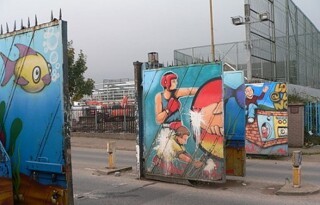Between the Lines
Peter Geoghegan · Belfast's 'Peace Lines'
In 1971, a parliamentary Working Group criticised the speed with which walls, gates and fences were being put up to separate Catholic and Protestant communities in Northern Ireland. The ‘peace lines’, constructed mainly by the British army, were creating an ‘atmosphere of abnormality’, the Peace Walls Working Group warned. But they did ‘not expect any insurmountable difficulty in bringing together well-meaning people from both sides’, and believed that before long, the barricades would come down; ‘normality’ would return.
Dismantling the ‘peace lines’ wasn’t a requirement of the Good Friday Agreement. Between 2000 and 2007, seven new barriers were put up and 16 old ones rebuilt or extended. Their history long predates the Troubles, too. In the mid 19th century, the route of the Dublin-Belfast railway was planned deliberately to separate Catholic Pound Loney from Protestant Sandy Row. In 1935, after weeks of sporadic violence in Belfast’s Docklands, with Loyalist snipers firing into nearby Catholic areas, the military built a large fence across Nelson Street.
The corrugated iron fence that bisects Alexandra Park in North Belfast is 120 metres long and 3.5 metres high. Its foundations were laid on 1 September 1994, the day after the army council of the Provisional IRA had announced a ‘complete cessation of military operations’. Seven months ago, a ‘peace gate’ was opened in the fence. Between 9 a.m. and 3 p.m., you can walk from the Loyalist Shore Road end of the park to Republican Antrim Road without having to take a half-hour detour. The North Belfast Interface Network, a community group that spent three years canvassing local residents before the gate was opened, reports no incidents of violence in the park since September.
For civic boosters, however, this modest achievement can’t begin to compete with the centenary of the Titanic’s maiden voyage (the ship was built in Belfast). Sixty million pounds of public money was plunged into Eric Kuhne’s shimmering Titanic Belfast ‘experience’, with millions more in PFIs for the Titanic Quarter redevelopment project. Meanwhile, Northern Ireland’s community sector is reeling from a succession of cuts. The North Belfast Interface Network, which employs five staff in a poky office near Solitude, the home of Cliftonville FC, is struggling to stay afloat. Last year it received £165,000 in funding. For 2012, it has so far secured only £62,000.

Comments
I rode back in a cab to the airport with a bunch of quite drunk, crying mummies who were in mountains of mourning for their prematurely deceased pal, whilst I was also leaving my blankly staring mate, her widower, on his native soil, with two very young sons. We had the privilege of passing within a stone's throw of Hurricane Higgins' flat, where he had just that minute died, though we didn't know that at the time. The driver fraternally advised me that it was the "Black Label" which would really flush the grief out of the girls in the airport bar, something I had suggested to make the most of the day. The people throughout the north really are incredibly unbland - in any sad circumstance - greatened by their divisions, possibly, certainly kept on their toes by it, but obviously all completely the same anyway, and probably know and suspect it all the time.
My friend talks well of the great new road which runs to the south.